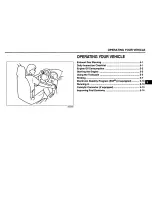
18
n
Tyre pressure warning (RDW)
*
Since neither emergency run-flat sys-
tem enables tyre pressure loss to be
easily identified visually, BMW cars with
emergency run-flat wheels and tyres
are equipped ex-factory with a tyre
pressure warning system (RDW).
Operating principle
The RDW system monitors tyre pres-
sures in all four road wheels as the car
is being driven. It warns the driver if a
significant loss of pressure is detected
in one or more of the car's tyres.
To enable the RDW system to "learn"
the correct tyre pressures, first check
them at all wheels, compare them with
the table on page
21
and correct them
if necessary. Then activate the RDW
system.
Activating the system
1 Turn the ignition key to position 2
2 Keep the button (arrow) pressed until
the Check Control displays "SET
TYRE PRESSURE" for several sec-
onds
3 The RDW runs an automatic detec-
tion cycle as the car is being driven,
and memorises these desired values.
This once-only learning process
takes at least 10 minutes, after which
the RDW system is ready to identify
and warn against tyre failures.
The same procedure should be re-
peated whenever the required tyre
pressures are changed or a new wheel
or tyre fitted.
39mde031
Tyre failures
If a tyre develops a fault which leads to
air pressure being lost, the Check Con-
trol displays "TYRE DEFECT" and a
gong signal is heard.
If this display appears, it is essential to
comply with the driving instructions
stated on page
17
(depending on which
emergency run-flat system is fitted to
your car).
Reduce the car's speed carefully and
adopt a restrained driving style. Try to
avoid severe longitudinal or lateral ac-
celeration.
The RDW system only registers air
pressure loss and is therefore un-
able to inform the driver of possibly se-
rious tyre damage caused by external
effects.
<
















































